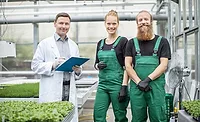Social Responsibility’s Influence Over Food Safety and Quality

The concept of social responsibility has saturated social media over the last few years and crept into the organizational pillars of many corporations. In its infancy, green/responsibility initiatives were often placed with the quality leaders, which was a fairly intuitive decision. Whether trying to make a better product or make the world a better place, social responsibility and food safety/quality (FSQ) share the common roots of striving to “do the right thing.”
Social responsibility initiatives have evolved, and today, many large companies have separate corporate social responsibility (CSR) departments. CSR encompasses a variety of facets: environmental conservation, community outreach, sustainable sourcing/animal welfare, good labor practices, etc. As this concept of “doing the right thing” has expanded over the years, its influence over FSQ objectives continues. Often, one will pay dividends for the other, although there are definitely circumstances where they come into conflict.
Food Insecurity vs. Expiration Dates
One of the most pressing problems facing our country continues to be hunger, and Golden State Foods’ director of CSR, Anna Lisa Lukes, shed some light on the true extent of this problem. “Hunger is a rampant and real problem for so many Americans that finding a solution to avoid food waste while at the same time feed children and families who would otherwise turn to food banks should be an ambitious aspiration for those who are in a position to make a difference.” It’s believed that one in six children, or nearly 13 million kids, in the United States is food insecure or may not know where they will get their next meal, according to Feeding America, a nonprofit organization whose mission is to feed America’s hungry through a nationwide network of member food banks and engage our country in the fight to end hunger. Feeding America estimates that each year, 46 million people turn to its network food banks for support.[1]
How can there be such a devastating problem in a country with so many agricultural resources? A large contributor is the enormous amount of edible food that is discarded every day. Forty percent of our total production, or 133 billion pounds of food in our nation, go to the landfill annually.[2] Sadly, that makes food waste the largest contributor to municipal landfills across the United States.[3]
It is alarming how much edible food is wasted in this country, much of it by people with a misconception about its wholesomeness due to an expired date on the package. These ubiquitous dates come in a variety of flavors: Use Through, Sell By, Use By, etc. The public has been trained to faithfully and regularly cull out-of-date products from their pantries and fridges, sending them often straight into landfills.
Many organizations, such as Feeding America, are actively partnering with major global food companies to provide aid. These industry players are committed to donating wholesome products that might not meet strict customer standards. Governmental agencies have also committed to aiding this cause. In 2013, the U.S. Department of Agriculture (USDA), in partnership with the Environmental Protection Agency, created the U.S. Food Waste Challenge. This initiative brings together government, industry, academia and nonprofits with the goal of reducing 50 percent of food waste in landfills by 2030.[4] The mission revolves around the three Rs: Reducing food waste by improving product development, storage, shopping/ordering, marketing, labeling and cooking methods; Recover food waste by connecting potential food donors to hunger relief organizations; and Recycle food waste into other product streams (animal feed or compost). This partnership is making inroads with thousands of participants. In 2016, USDA released new guidelines on date labeling, encouraging the use of “Best if Used By” to eliminate consumer confusion and decrease the amount of wholesome product that is needlessly discarded.[5]
Congress is trying to take this a step further by creating two proposed pieces of legislation—the Food Recovery Act and the Food Date Labeling Act. These would offer possible solutions by reducing consumer confusion, simplify regulatory compliance for companies and cut supply chain and consumer waste.[6] Now that the problem has gained strong attention, the industry can start making changes to stem the flow of edible product into this country’s landfills.
The Integral Role of Sustainable Sourcing in Food Safety
There is a deep quandary around certain agricultural products, which are largely sourced from developing regions. Items such as herbs, spices, coffee and palm oil need a particular climate to grow in the quantities needed to satisfy consumer demand. Industry leaders have partnered with global outreach organizations, such as the Rainforest Alliance, and fair trade initiatives to propagate education to these developing areas. A report commissioned by the United Kingdom and Norwegian governments found that agriculture is the biggest contributor to deforestation, causing up to 80 percent of losses worldwide.[7]
Often, these areas of the world are largely rural and lack the strict agricultural practices and processing standards that have become common for developed nations. Large corporations, which often depend on developing areas for their raw agricultural materials, have gone so far as to incorporate a vertical sourcing system, working firsthand with local growers and processors to ensure that their products are being raised and processed in a controlled, responsible manner.
There is sometimes a lack of education among growers and misconceptions abound, such as “a little pesticide/herbicide/fertilizer is good, more must be better.” Some of these practices greatly increase the likelihood of contaminating product, which is grown, harvested and often processed in these regions. These practices (increased chemical use, lack of crop rotation and certain harvesting techniques) may eventually lead to devastating harm to the farms and surrounding countryside. The vertical sourcing system has greatly benefited the companies as well as the local people by giving them the knowledge and tools to become safer and more efficient farmers; it has also helped preserve sustainable agricultural practices. Initiatives to protect and preserve local resources will ensure that there will be a sustainable supply of raw materials for future generations to enjoy.
Another benefit to controlled sourcing has been less likelihood of food fraud. Unfortunately, cases of large-scale intentional adulteration have often come from these rural areas where the people are so dependent on crop yields and under extreme pressure to meet quotas. Close communication with local farmers, assistance with resources and firm expectations can aid in combating this risk.
The combined outreach efforts of these large corporations, global organizations and universities have positively influenced sustainable Good Agricultural Practices and food safety standards in every part of the globe.
The Contribution of Animal Welfare to Quality
Animal welfare programs were widely adopted after the Humane Slaughter Act of 1958 was passed into law,[8] setting the stage for appropriate treatment of agricultural animals in the United States. Innovations in animal husbandry, transportation and slaughter have grown into an industry of their own. There are regulations, audits, consultants and experts devoted to animal welfare.
There are few in the protein industry who don’t recognize the name Dr. Temple Grandin, a huge proponent of this movement since the beginning of her nearly 50-year career. In the 2010 Time 100, an annual list of the 100 most influential people in the world, she was named in the “Heroes” category.[9] Grandin was one of the first scientists to understand the extent that visual distractions influence animal behavior. She is famous for saying, “I think using animals for food is an ethical thing to do, but we’ve got to do it right. We’ve got to give those animals a decent life and we’ve got to give them a painless death. We owe the animal respect.” Her designs for processing facilities serve to decrease stress in the animal prior to slaughter.
Researchers, Grandin among them, have drawn conclusive links that animal stress preslaughter produces many quality defects in meat. Defects such as bruises, blood clots and blood splash are often caused by injury prior to processing. When herd animals become agitated, they can often panic others, leading to kicking, gouging and biting. Improper animal control can also lead to crowding, with animals often pushing one another against fences.
Body chemicals generated through periods of great stress also have a direct correlation to negative changes in muscular tissue. Ideally, a calm, well-rested animal has high levels of glycogen, a sugar found in muscle that produces lactic acid postslaughter. Preslaughter distress consumes this sugar, causing reduced lactic acid levels. This chemical reaction is responsible for major meat defects such as dark, firm, dry (DFD) and pale, soft, exudative (PSE). DFD is found primarily in sheep and cattle when decreased lactic acid levels raise the pH. This can lead to a dark, unpleasant color and unacceptable flavor notes. Extreme anxiety in pigs may lead to PSE, which results in lighter-colored meat, which has trouble retaining moisture during cooking and also may lead to decreased flavor. The resultant reduced glycogen levels lower yields and shorten shelf life by increasing spoilage (lactic acid retards microbial growth), which creates unnecessary food waste.[10]
Studies have shown a marked decrease in these negative meat attributes in animals handled humanely. Preventive measures, such as redesigned corrals and entry tunnels, have been added to much of the country’s processing facilities to reduce injury.[11] The meat industry has done a remarkable job embracing animal welfare practices, much of which is self-regulated through global standards and third-party audits.[12] Customers often make animal welfare programs a mandatory part of their vendor management policies, requiring their suppliers to have animal welfare audits in addition to the more traditional FSQ audits.
Clean Labeling: Does It Cause More Food Waste and Increased Illness?
What is more alarming than reports of poisonous substances in baby food? There’s been a trend of sensational studies in the media, many of which have been discredited,[13] which have shifted consumer focus, once again, to examining food labels. This time, they are analyzing ingredient statements, and much of the public does not like what they’ve found. The decades-old demand for organic, minimally processed foods has morphed into a true concern about hidden ingredients. Artificial colors, flavors and preservatives (really any chemical-sounding name) are the new four-letter words of social media forums.
U.S. companies are scrambling to find natural alternatives to artificial colors. The fact remains that many natural colors are not as bright or long-lasting as their artificial counterparts. Americans like the sound of natural ingredients, but will they stand for brown strawberry syrup or a product that has a reduced shelf life? Consumers have a high standard for aesthetically pleasing, long-shelf-life, convenient products that require short preparation.
The public doesn’t seem ready to hear that preservatives are necessary in some foods when there is no acceptable natural alternative. There has been a push to utilize alternative technologies such as high-pressure processing and ultrahigh-temperature pasteurization to grant that extra level of food safety. Some supply chains have been completely reformatted, going from an ambient-temperature to a refrigerated product in the hopes of extending shelf life, sustaining quality and increasing the certainty of safety.
In truth, no one is sure about the long-term ramifications of these initiatives, which have spurred many companies to reexamine legacy formulas and find new ways to ensure robustness (lowering pH and water activity, utilizing safer ingredients and new processing technologies) in the absence of certain chemical ingredients. This is a good thing, but it still remains to be seen if we see an uptick in foodborne illness outbreaks due to riskier formulation. As discussed above, it’s fairly certain that with a reduction in shelf life, we’ll be seeing more expired products make their way from pantry shelves into landfills.
Water Conservation: Can It Decrease Facility Microflora?
Facilities that begin a sustainability program often start with water conservation. It’s amazing how many little drips and leaks are collectively found around a large manufacturing plant, especially one that utilizes water in its process. Water audits often take the form of kaizen events (a series of small events attended by department leaders) that seek to identify and rectify dozens of plant leaks that often go undetected during normal operations. These may even extend to the annex buildings and surrounding grounds. The goal of these kaizen activities is realized over time when their accumulated effects lead to annualized cost savings in utility bills and relief to wastewater treatment plants.
The next facet to these water conservation efforts is often reducing water during traditional cleanup operations, which in many industries are the leading contributors to water usage. Anyone who has witnessed a third-shift wet sanitation cycle has experienced the sauna created when hundreds of gallons of hot water are poured onto equipment and surfaces to return operational areas to clean and sanitary conditions. Extremely hot, high-pressure water has always been the main tool to remove lipids and melt fat. Unfortunately, what often happens is that water is overused during these cleaning operations. It doesn’t take a trained sanitor to tell you that moving food particles around with a high-pressure hose is much easier than sweeping or removing by hand. It takes constant training and careful management to ensure that overusing water doesn’t become standard practice.
Using less water is undeniably good for the environment and translates to a real cost savings over time—a real “win-win” situation. There’s actually a third win in this scenario. Sanitation expert Dr. Jeffrey Kornacki has long maintained that utilizing less water during sanitation can actually improve the microflora of an establishment by eliminating wet niches that are ideal for biofilm development. Biofilms develop when bacteria congregate, secreting polysaccharides, proteins and glycoproteins to improve adherence to surfaces. Moisture is a key component. As this film develops, it also acts as a protective barrier to external stresses (heat and sanitizers) and gives the bacteria access to nutrients and an opportunity for genetic exchange.[14] A fully formed biofilm is extremely hard to remove, and many sanitation strategies stress the importance of prevention.
Nothing strikes fear in the heart of a quality assurance manager quicker than those two letters “LM.” Listeria monocytogenes biofilms are commonly found in manufacturing environments that host wet conditions. Increased concerns over domestic Listeria outbreaks over the last decade have triggered the U.S. Food and Drug Administration to release guidance on reducing this pathogen in food production environments.[15] Sanitation recommendations are included in this document: proper drainage, minimal use of high-pressure water during operations and other means of reducing moisture in processing areas.
At a recent industry meeting, Kornacki outlined several methods as an alternative to or in conjunction with traditional wet sanitation. All these methods contribute to water conservation efforts, reduce moisture in the plant and can aid in reduction of biofilm development. There are several types of blast cleaning, in which some type of medium (soda, sand, plastic beads or dry ice) is accelerated in a pressurized airstream to strike a surface to be cleaned and lift debris. Another type of dry cleaning utilizes vacuum technology. Dust and debris can harbor environmental pathogens such as Salmonella. Traditional dry cleaning methods using compressed air can expand the spread of such pathogens. Modern techniques often utilize centralized vacuum systems and mobile vacuum backpacks to access hard-to-reach areas. Dry steam cleaning utilizes superheated steam (~212–240 °F) via nozzles to directly apply heat to surfaces, greatly reducing the water needed and generating almost no wastewater runoff. Many companies have started using dry sterilant gases (e.g., ozone, chlorine dioxide, hydrogen peroxide vapor) to accompany traditional cleaning.
Observing sanitation and noting how long water is used in a certain area is an easy way to begin a water-reduction initiative. Certain surfaces could be better cleaned utilizing a cloth and sanitizer/disinfectant, especially electrical boxes, control panels and areas around delicate instruments. This practice might be more labor intensive but will certainly be gentler on sensitive equipment. There are ways of possibly reducing sanitation labor. Including engineering/maintenance personnel to identify equipment that could be further broken down during daily or periodic sanitation can make this process more efficient. Trend your preoperational observations and microbiological surface testing to better understand your problem areas and make accurate decisions on the proper cleaning frequency in different parts of the plant. Once you’ve exhausted your in-house talent, sanitation consultants may offer further aid. Many companies bring in experts to streamline sanitation practices, including overhauling enclosed clean-in-place systems to ensure maximum efficiency and reduce use of unnecessary water and chemicals.
Collaborative Efforts
Lastly, both CSR and FSQ practitioners share an unprece-dented proclivity toward collaboration. Even among direct competitors, leaders in these fields are the first to share innovations, encouraging others to adopt best practices. In an extremely competitive business, there’s a drive for continuous improvement, not just for individual companies but also for the entire field. Conferences are held solely to share this knowledge. For example, the International Association of Food Protection brings industry leaders from around the world to share both wins and losses. Seeing an industry leader speak honestly about mistakes and what has been done to correct them presents a stark transparency that is rarely seen anywhere else. More than any other, these two disciplines are not seen as a competitive advantage. Often, harm for one company can have devastating repercussions for everyone in that industry through consumer avoidance, increased regulations or negative connotations of similar products. Both sectors have entire sessions focused on what large businesses can do to uplift smaller ones. There’s absolutely no advantage, just following the mantra of trying to “do the right thing.”
CSR initiatives are by no means found solely in the food industry, but they seem to have a direct influence over many facets of FSQ. Many of these coincide in a collaborative effort yielding positive results, but there are potential conflicts and pitfalls to be considered in others.
Wendy White, M.Sc., is the director of corporate food safety and quality at Golden State Foods and is on the Editorial Advisory Board of Food Safety Magazine. She can be reached at wwhite@goldenstatefoods.com.
References
1. www.feedingamerica.org/.
2. Hall, KD et al. 2009. “The Progressive Increase of Food Waste in America and Its Environmental Impact.” PLoS ONE 4(11):e7940.
3. www.usda.gov/oce/foodwaste/faqs.htm#ChampionsFAQs.
4. www.usda.gov/oce/foodwaste/Challenge/index.htm.
5. www.fsis.usda.gov/wps/portal/fsis/
newsroom/news-releases-statements-transcripts/news-release-archives-by-year/archive/2016/nr-121416-01.
6. pingree.house.gov/foodwaste.
7. www.gov.uk/government/uploads/system/
uploads/attachment_data/file/65505/6316-drivers-deforestation-report.pdf.
8. www.nal.usda.gov/awic/humane-methods-slaughter-act.
9. content.time.com/time/specials/packages/article/0,28804,1984685_1984949_1985222,00.html.
10. FAO Guidelines for Humane Handling, Transport and Slaughter of Livestock; chapter 2: www.fao.org/docrep/003/x6909e/x6909e04.htm.
11. www.grandin.com/welfare/intro.welfare.html.
12. www.nal.usda.gov/awic/animal-welfare-audit-and-certification-programs.
13. www.forbes.com/sites/kavinsenapathy/2017/10/31/the-clean-label-project-is-using-bad-science-to-scare-us-about-our-childrens-food/#779ac15271e9.
14. Jefferson, KK. 2004. “What Drives Bacteria to Produce a Biofilm?” FEMS Microbiol Ltr 236:163–173.
15. www.fda.gov/RegulatoryInformation/Guidances/ucm073110.htm.
Looking for quick answers on food safety topics?
Try Ask FSM, our new smart AI search tool.
Ask FSM →







.webp?t=1721343192)
